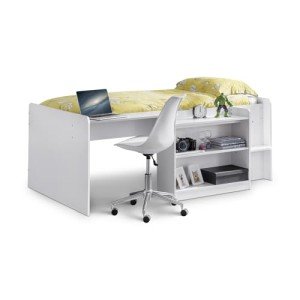The Most Powerful Sources Of Inspiration Of Kids Bunk Bed
The Ultimate Guide to Kids Bunk Beds: Maximizing Space and Fun
With the increase of vertical living and smaller sized areas, the popularity of bunk beds has skyrocketed amongst families. Bunk beds not just provide a useful sleeping option, especially in shared rooms, however they also bring a component of enjoyable into a kid's life. Recommended Reading looks into the functions, benefits, and considerations of kids' bunk beds, making it much easier for moms and dads to pick the best bed for their little ones.
Functions of Kids Bunk Beds
Bunk beds are flexible furniture pieces that serve more than a single purpose. Here are some crucial features to consider:
Feature
Description
Material
Bunk beds can be built from wood, metal, or a combination of both, using differing levels of durability and style choices.
Security Features
Many bunk beds come equipped with guardrails, protected ladders, and topped supports for safety, specifically crucial for kids.
Style Variety
Choices range from traditional styles to modern-day designs, guaranteeing a match for any room décor.
Space-Efficiency
Bunk beds utilize vertical space, making them ideal for smaller sized spaces.
Convertible Options
Some models can be transformed into 2 different beds, offering versatility as kids grow.
Storage Solutions
Some bunk beds feature integrated storage drawers or shelves, helping to keep the space organized.
Advantages of Kids Bunk Beds
Buying a bunk bed comes with a number of advantages:
- Space Saving: Bunk beds maximize flooring space, enabling more play area or storage options.
- Enjoyable Factor: With a bunk bed, kids belong that promotes imagination and companionship throughout pajama parties or playdates.
- Cost-efficient: Instead of buying two separate beds, a bunk bed can accommodate 2 kids simultaneously, saving money in the long run.
- Versatility: Many bunk beds can be dismantled or transformed into twin beds, making them a long-term financial investment as kids's needs alter.
- Social Interaction: Bunk beds motivate family bonding and relationships, offering a welcoming space for children to share stories and laughter.
Factors to consider When Choosing a Kids Bunk Bed
When choosing the perfect bunk bed for a kid, parents should take into account various elements:
- Safety Standards: Ensure that the bunk bed abide by security policies and comes with necessary security functions.
- Age Appropriateness: Different models accommodate different age. For instance, traditional bunk beds might not be suitable for younger kids.
- Space Dimensions: Measure the bedroom to ensure the bunk bed fits appropriately, permitting space to move around conveniently.
- Weight Capacity: Consider the weight load of each bed and guarantee it accommodates the kid's weight comfortably.
- Design Preferences: Letting children get involved in the selection procedure can help them feel more fired up about their new bed.
Types of Kids Bunk Beds
Bunk beds are available in different designs and setups to suit different needs:
Type
Description
Requirement Bunk Bed
A timeless design with one bed stacked on top of another, typically using a ladder to access the top bunk.
L-Shaped Bunk Bed
Features 2 bunk beds connected in an L-shape, frequently more roomy and suitable for kids sharing a space however needing a bit more space.
Triple Bunk Bed
Comprises three stacked beds, suitable for optimizing sleeping arrangements in extremely minimal spaces.
Loft Bed
A raised bed with space below that can function as a play area, study corner, or extra storage.
Futon Bunk Bed
Combines a bunk bed on top with a futon or couch beneath, making it great for slumber parties and optimizing room use.
Convertible Bunk Bed
Can be separated into two private beds, offering versatility as kids's requirements change.
Caring for Kids Bunk Beds
Maintaining bunk beds is essential for guaranteeing longevity and security. Here are some basic care practices:
- Regular Inspections: Check the bed frequently for loose screws and tightened bolts to ensure stability.
- Cleanliness: Keep bedding tidy and fresh, turning bed mattress for even use.
- Guardrails: Ensure guardrails are safe and secure and in place, specifically if kids tend to move a lot in their sleep.
- Air Circulation: Ensure the bed has adequate airflow, preventing moisture accumulation that can lead to mold or mildew.
Frequently Asked Questions About Kids Bunk Beds
Q1: At what age can a child securely use a bunk bed?
A1: Generally, kids aged 6 and older are considered safe to utilize the upper bunk due to the height and stability factors involved.
Q2: Can I place a bunk bed near a window?
A2: It is a good idea to prevent putting a bunk bed near windows to reduce the danger of falling or injuries.
Q3: Are bunk beds safe for younger kids?
A3: While some contemporary bunk beds feature safety features accommodating younger children, it is generally suggested to wait until they are older, usually over 6 years.
Q4: What is the common weight limit for leading bunks?
A4: Weight limitations vary by model however normally range from 150 to 250 pounds. Constantly refer to the manufacturer's specifications.
Q5: How often should I examine the bunk bed's security functions?
A5: It is advisable to conduct a safety check every few months or whenever you observe any signs of wear.
Kids' bunk beds function as a strategic option for households seeking to maximize space while providing a fun and engaging sleeping environment for their children. With a range of alternatives readily available— from standard designs to loft beds— parents have the freedom to choose something that satisfies their family's particular requirements. By thinking about important elements such as security, space suitability, and their kids's preferences, parents can make an educated choice, making sure that each kid is excited about bedtime while gaining from an efficient room.
